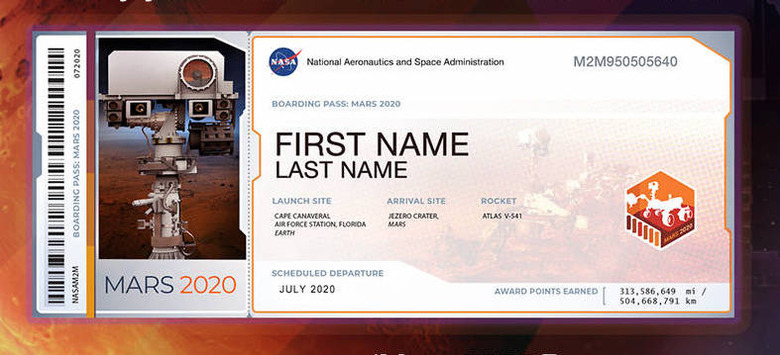NASA Mars 2020 Mission Is Taking Passenger Names - But Not How You Think
NASA may not be ready to take passengers to Mars, but you'll be able to put your name down in the meantime – quite literally. The space agency is offering "frequent flyer" points along with souvenir boarding passes to members of the public for a trip to Mars, as part of its push around the Mars 2020 mission.
The names will be dispatched with the Mars 2020 rover, which is currently under construction. The fifth rover to head to Mars will have a new range of tools and testing equipment; it'll also be the first to drill out samples of Martian rock and soil. Eventually, NASA says, it hopes to operate a Mars mission which will be able to bring back such samples for testing here on Earth.
The "Send your Name to Mars" project won't cost anything to take part in. Instead, it just asks for your first and last name, your country and postal code, and your email. In return, you'll get the "frequent flyer" points. So far, almost a million people have signed up – NASA is taking submissions until September 30, 2019.

How those names will be sent to Mars is arguably even more interesting. The Jet Propulsion Laboratory responsible for managing the Mars 2020 mission and the new rover has turned to its Microdevices Laboratory for help. There, an electron beam will be used to stencil every submitted name onto a silicon chip.
Each line of text will be smaller than 75 nanometers, or a thousandth of the width of a human hair. NASA will be able to carve more than a million names onto a chip the size of a dime as a result. The final chip – or chips, at this rate, given the interest already shown – will be embedded under a glass cover on the body of the rover.
It may seem like an odd stunt, but there's good reason for NASA to try to get as many people involved with Mars 2020 as the agency can. After all, it's competing for budget with numerous other projects, and the results won't exactly be delivering immediate gratification. The new rover isn't scheduled to take off until July 2020 at the earliest, and even then its roughly seven month transit will mean it won't reach Mars until February 2021.
NASA showed off the completed space craft within which the rover will make that lengthy trip for the first time earlier this week, test assembling the whole structure. If everything goes to plan, it'll be another step in the process to sending humans first back to the Moon in 2024, and then onward to Mars. To achieve that, NASA will need not only US government funding but the assistance of industry and international partners.
